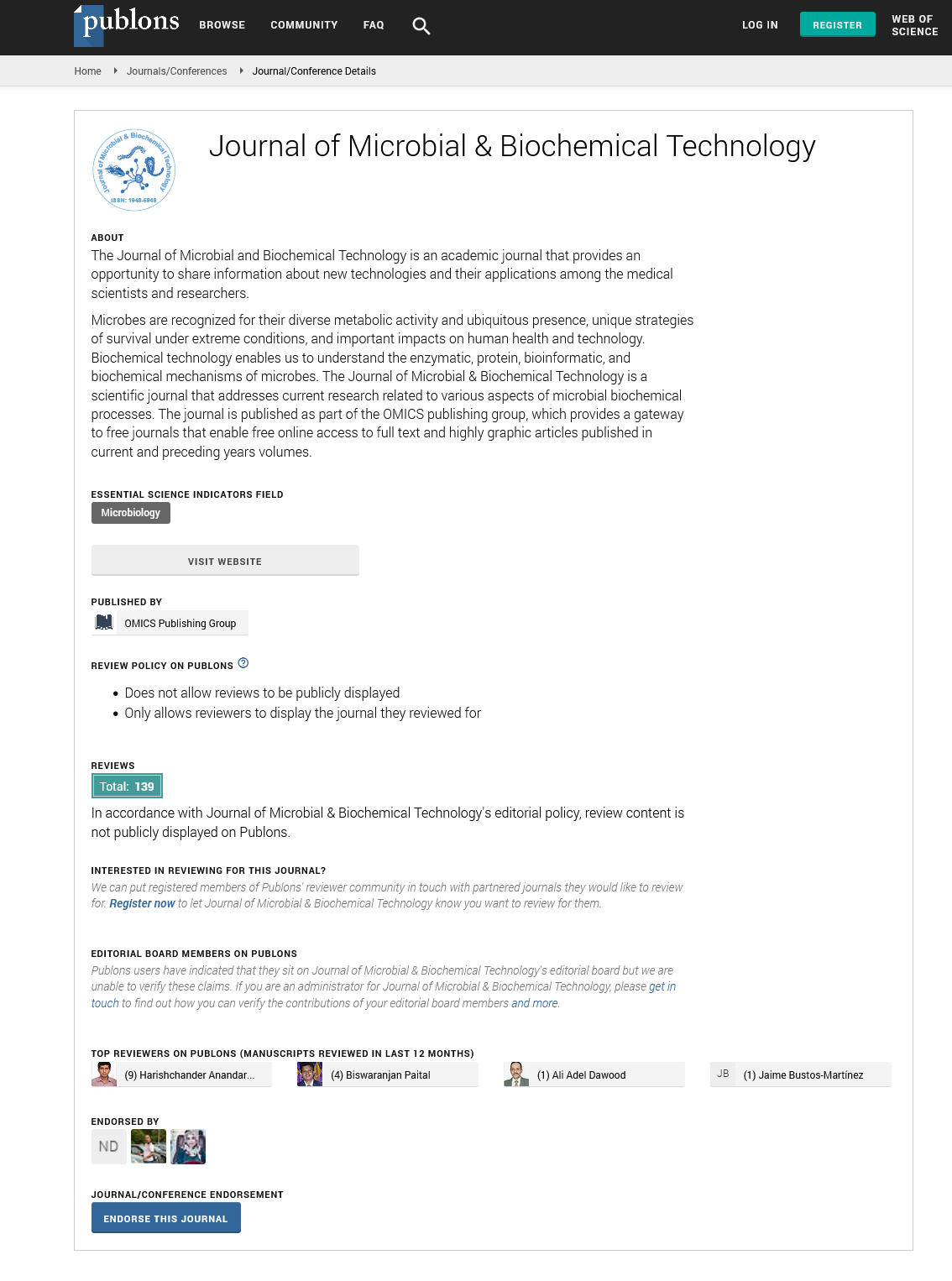Indexed In
- Academic Journals Database
- Genamics JournalSeek
- Academic Keys
- JournalTOCs
- China National Knowledge Infrastructure (CNKI)
- Scimago
- Access to Global Online Research in Agriculture (AGORA)
- Electronic Journals Library
- RefSeek
- Directory of Research Journal Indexing (DRJI)
- Hamdard University
- EBSCO A-Z
- OCLC- WorldCat
- SWB online catalog
- Virtual Library of Biology (vifabio)
- Publons
- MIAR
- University Grants Commission
- Geneva Foundation for Medical Education and Research
- Euro Pub
- Google Scholar
Useful Links
Share This Page
Journal Flyer

Open Access Journals
- Agri and Aquaculture
- Biochemistry
- Bioinformatics & Systems Biology
- Business & Management
- Chemistry
- Clinical Sciences
- Engineering
- Food & Nutrition
- General Science
- Genetics & Molecular Biology
- Immunology & Microbiology
- Medical Sciences
- Neuroscience & Psychology
- Nursing & Health Care
- Pharmaceutical Sciences
Opinion - (2024) Volume 16, Issue 3
Microbial Fuel Cells: A Novel Approach to Wastewater Treatment and Renewable Energy Production
Mateo Basurto*Received: 26-Aug-2024, Manuscript No. JMBT-24-27273; Editor assigned: 28-Aug-2024, Pre QC No. JMBT-24-27273; Reviewed: 11-Sep-2024, QC No. JMBT-24-27273; Revised: 17-Sep-2024, Manuscript No. JMBT-24-27273; Published: 25-Sep-2024, DOI: 10.35248/1948-5948.24.16.619
Description
Microbial Fuel Cells (MFCs) represent a innovative technology that merges wastewater treatment with renewable energy production, addressing two critical global challenges: The management of wastewater and the pursuit of sustainable energy solutions. By controlling the metabolic capabilities of microorganisms, MFCs convert organic pollutants in wastewater into electrical energy while simultaneously treating the effluent. This dual functionality positions MFCs as an innovative approach to achieving sustainable environmental management and energy generation, with significant implications for both wastewater treatment processes and renewable energy strategies.
The fundamental principle of MFCs lies in the ability of certain microorganisms to transfer electrons derived from the oxidation of organic substrates directly to an electrode. This electrochemical process occurs in anaerobic conditions, where microorganisms metabolize organic matter, generating electrons and protons. The electrons travel through an external circuit, producing electrical current, while protons migrate through a proton exchange membrane to the anode compartment, where they recombine with the electrons to form hydrogen ions. The biocatalytic activity of the microorganisms facilitates this process, allowing MFCs to effectively treat wastewater while generating power.
One of the most compelling aspects of MFCs is their versatility in treating a wide variety of wastewater types, including domestic sewage, agricultural runoff and industrial effluents. The organic matter present in these waste streams serves as an ideal substrate for microbial metabolism, enabling efficient removal of pollutants such as carbohydrates, fats, proteins and even toxic compounds. This not only contributes to the reduction of Biochemical Oxygen Demand (BOD) and Chemical Oxygen Demand (COD) in the effluent but also facilitates the recovery of valuable resources such as nutrients (nitrogen and phosphorus) that can be reused in agriculture.
The efficiency of MFCs is influenced by several factors, including the choice of microbial consortia, electrode materials and reactor design. Recent advancements in bioengineering have enabled the optimization of microbial communities to enhance their electroactivity and substrate degradation rates. For instance, mixed microbial cultures, often sourced from natural environments, have demonstrated superior performance due to their diverse metabolic capabilities, allowing them to degrade a wider range of organic compounds. Additionally, the selection of conductive and biocompatible materials for electrodes can significantly impact the overall performance of MFCs. Research is ongoing to explore innovative electrode materials, such as carbon nanotubes, graphene and metal-organic frameworks, which can improve electron transfer efficiency and enhance power output.
In terms of reactor design, several configurations have been explored to maximize the performance of MFCs. These include single-chamber and double-chamber designs, as well as stacked and tubular arrangements. Each design has its advantages and disadvantages in terms of ease of operation, scalability and energy output. For example, single-chamber MFCs offer simplicity and lower costs, while double-chamber systems typically provide higher power densities due to the separation of anode and cathode compartments, facilitating more effective substrate oxidation and electron transfer. Continuous flow systems and batch reactors have also been developed to optimize retention times and substrate utilization, further enhancing the efficiency of the process.
Beyond wastewater treatment, MFCs have shown potential for integrating with various renewable energy systems. For example, coupling MFCs with anaerobic digestion can enhance the overall energy recovery from organic waste. In this setup, the biogas produced during anaerobic digestion can be fed into the MFC to supplement energy production, creating a synergistic effect that maximizes resource recovery and energy generation. Furthermore, MFCs can serve as a decentralized energy source in remote or off-grid locations, where traditional energy infrastructure may be lacking. The ability to convert organic waste into electricity on-site offers a sustainable solution for communities facing energy scarcity.
The economic viability of MFCs is a critical consideration for their widespread adoption. Although MFC technology has advanced significantly in recent years, challenges remain in terms of cost-effectiveness and scalability. Research is focused on optimizing operational conditions, reducing materials costs and improving energy output to make MFCs commercially viable for large-scale applications. The integration of MFCs into existing wastewater treatment plants as a supplementary energy source or as part of a hybrid treatment system represents a promising pathway for enhancing the economic feasibility of this technology.
In addition to their practical applications, MFCs provide a platform for fundamental research in microbiology, bioelectrochemistry and environmental science. Studies investigating the complex interactions between microbial communities and electrode surfaces can yield valuable insights into microbial behavior, electron transfer mechanisms and the development of bioelectrochemical systems. This knowledge can inform the design of more efficient and effective MFCs, ultimately advancing the field of bioenergy and sustainable environmental management.
Citation: Basurto M (2024) Microbial Fuel Cells: A Novel Approach to Wastewater Treatment and Renewable Energy Production. J Microb Biochem Technol. 16:619.
Copyright: © 2024 Basurto M. This is an open access article distributed under the terms of the Creative Commons Attribution License, which permits unrestricted use, distribution, and reproduction in any medium, provided the original author and source are credited.

